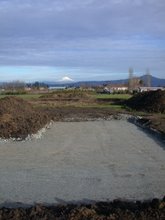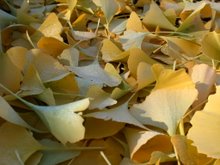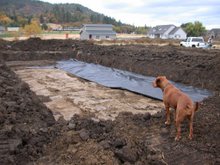After 2 1/2 days of heating the concrete slab, 4 out of 5 zones have warmed up enough to achieve ambient air temps. of 68 degrees. Only the Master Bedroom at the far end of the bedroom wing is lagging - at 64 degrees. This might be because it's both the longest run of tubing (probably almost 600 linear feet, due mostly to an error in laying out the tubing on my part...) and because of air leaks around the doors and attic access hatch opening.
Feliz Navidad...
Sunday, December 23, 2007
Subscribe to:
Post Comments (Atom)









19 comments:
Hey Scott, How is the heat working?My heating was a diy too, and we too had a few bugs to work out. It took me a while though (about 2 months). My pump head was too high so the pumps I tried to use were too small. Not only did I have to buy a new pump (I decided KISS was best for me and went with one pump instead of two), I already had to rebuild my manifolds with larger plumbing anyway. I went from 3/4" to 1". That lowered the pump head enough to allow the new larger pump to work properly. Take care, Merry Christmas, and Happy New Year, Troy
Hi Troy,
Heat is working great! It just took 3 days to reach full temp. We didn't DIY the heat system (well, we installed it and hooked the pieces together). The manifold, pump and trim kit for the boiler came pre assembled from a company in Washington. I've been very happy with it so far.
Did you insulate around the perimeter of your slab?
Happy New Year to you as well.
Scott.
Scott, We insulated under the slab with 2" blue poly board. Did the same around the entire perimeter of the slab as well. I didn't dig down and insulate toward the footers because 99% of my slab is atleast 12" or more below grade anyway. The extra perimeter digging/insulation was recommended by a couple of folks, but I didn't see any reason.
Troy
Also, we had to insulate under the slab because the ground is very damp here, otherwise I might have left out the underslab insulation.
obtw, glad to hear that your heat works well. We love ours very, very much.
Troy.
Thanks Troy,
So, did you flash over the exposed insulation or stucco over it? I didn't want to deal with having to cover the insulation (what insulation is exposed above grade) - however I'm having second thoughts and might just end up putting some in before backfilling.
Scott.
Sorry Scott, I was talking about the perimeter around the slab on the inside of the house which we did insulate. Also, I did place blue fan fold (not sure of its true name, but it comes in 3'x50'x1/4"?) on the outside below grade. I first used tar foundation coating then placed the fan fold over top. I over lapped so water would run down the outside of the fan fold. Much of my house is underground, and I left the fan fold off everything above ground. It's not much insulation, but it's something. Glad I did it, kinda wish I'd went with at least 1/2" blue board though. Concrete seems to transfer hot and cold very very well, and I think it's well worth the time to add the extra insulation. It might be worth mentioning that the tar sealed the top of the insulation to the blocks. About a month ago I tried to remove a little and it seems to be stuck there forever. I can’t see how water would ever penetrate the seal. Happy New Year, Troy
Hi Scott, Well I just looked at your slab pour photos. Looks like the floor and footers etc. are all connected. If so, I would try to insulate anything exposed to the outside. It may take a little more work and money, but I think it would be well worth your efforts.
Troy.
Hi Troy,
That's the problem - we don't have a thermal break between the slab and the giant footers. I think we'll run 2" rigid insulation around the perimeter and cover the exposed top with metal flashing.
Thanks.
Scott.
Hi Troy,
Previously you mentioned cleaning the residue from the ferrous sulfate before sealing the floor.
Did you just mop the hell out of the floor, or do you have some other tricks to suggest? Also, is your boiler electric or gas? If it's electric, I'm curious how many KWHs it takes to heat your house. My house is warm, but a heat hog (at least for now). I think the perimeter slab insulation is mandatory.
Thanks,
scott.
Hey Scott,
Mop, Mop and re-Mop and then Mop some more. We used soap and water. Sorry no real tricks. Other than a shop vac to soak up some of the water. However, it really did help.
Sorry, this next part is going to be long...
As far as our floor heat goes I have a combo system using both electric and gas. I use an electric hot water heater to pre-heat the water and a propane tankless heater to "top it off". The tankless heater is a gas hog. The thing about the system is I can set the electric to do it all or just pre-heat. Our propane is low right now so I'm using the electric to do it all. I have a 40 gal tank with 4500 and 3800watt elements. I have both elements wired to it's own breaker and its own thermostat. I had to do this so that it would keep up with the demand. When both thermostats call for power they get the full 4500 and 3800 watts collectively. Otherwise when a standard elect tank needs both elements to run they split the wattage of the highest rated element.
This makes my hot water tank much more powerful, however it is a hog as well. When the outside temps are in the single digits over an extended period and no sun for solar gain heating with the “Tim Allen” hot water tank I’ve used as much as 100-125kwh/day for household electric (and 0 gal propane). That number can be cut in half if I use the electric tank (with normal wiring-no Tim Allen) to pre-heat and the tankless to top it off. This method I averaged about 50gal propane/month.
I also have a wood stove which I‘ve burned when the outside temps go below 30deg. I'm currently doing the math to add a water coil inside the stove. I think with this I can supply all my heating needs as well as DHW needs (my system is an open system so I use it for DHW as well.)
We have fairly cheap electric here because we have coal fired power plants. However, I've done a little research and was surprised to find how bad they are for us and our environment (read a new post on the front of our website www.helmickpharm.50megs.com )
The wood I burn is mostly dead fall or tree tops left from logging. My wood stove is 70% efficient while coal fired power plants are 35-40%. Co2 emissions are measured in grams for my wood stove and a coal fired power plant produces several pounds of co2 to get the same power/btus. Anyway, by next winter I plan to use mainly the wood stove to heat all hot water needs. I don’t advocate burning with a wood stove but I think it is right for us. Also, we would also like to convert to another source of power over the next few years.
I'm sorry this is so long winded.
I'd say you have a huge energy bleed at your footers. But once you get a thermal break on the outside you should see a night and day difference. I have one area in front of my main door that we did a poor job with insulating the perimeter and the difference is amazing. The floor is so cold there.
If you could throw some hay bales or anything against the footers to get you through the winter I’m sure you’d see a huge difference. Without a doubt the house (slab)would heat so much easier!
Troy.
One more thing. The house looks great. I love the new photos. Everyday I check your site for progress. Keep up the good work! Troy.
Ping, troy!
We gave the ferrous sulfate the old college try today. The result is that our floor seems too orange - shades of cheetos - for our tastes. I mopped the residue off and it seems better, but still perhaps too orange in spots. When you used the Manganese, was it straight manganese, or did you cut it with some other ingredients?
We're holding steady until we figure out what direction to go - ie, add more ferrous sulfate to darken the floor, or add another substance, such as the manganese or even a brown acid stain, to brown up the orange a little bit.
Thanks,
Scott.
Hi Scott,
We used the manganese straight up diluted with only water. I might suggest trying to dial it in inside of a closet or some place less conspicuous. The ferrious did get much darker with redish brown tones the more concentrated the ferrious mix. Also the color will change a good bit after the floors are sealed. You may try some sealer in a non-conspicuous place as well.
Good luck, Troy.
Troy,
where does one get Manganese?
Thanks,
Scott.
We bought manganese at a farmers supply store called Southern States. If you can't find it locally, I'd be happy to pick some up and send it to you.
Troy.
Thanks Troy,
I think we've located some locally, but I appreciate your offer.
Meanwhile, I've picked up some rigid insulation and will install it around the perimeter this week. Fingers crossed, I'm hoping for a jump in efficiency.
Scott.
Hey Scott,
I was wondering if you have seen this website? http://www.cathy-moore.com/house/stain.html
Hi Troy,
Cathy Moore's website was the one that first got me on the ferrous sulfate bandwagon! She seems to have used just enough ferrous sulfate for a subtle toned floor. Ours was Denver Bronco orange (in spots). A LOT of scrubbing later, plus the addition of a Mahogany acid stain, and the floor is looking better - mottled, with rusts and brown tones, plus the original gray concrete.
On the radiant heat front - the addition of perimeter insulation cut our energy use by 2/3s.
Scott.
The floor sounds beautiful. Have you tried any sealer yet? If not it should make the colors that much richer/deeper. With sealer you should see a noticeable difference. Can't wait to see pictures!
Your house has to be way better insulated than mine and I'll bet it seems toasty warm now.
Troy.
Post a Comment